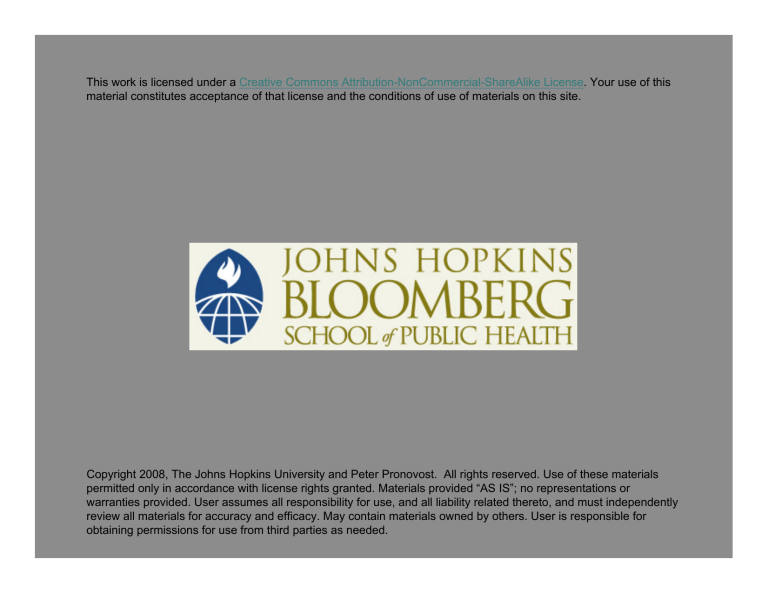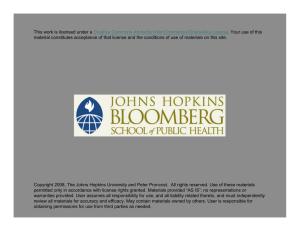
This work is licensed under a Creative Commons Attribution-NonCommercial-ShareAlike License. Your use of this
material constitutes acceptance of that license and the conditions of use of materials on this site.
Copyright 2008, The Johns Hopkins University and Peter Pronovost. All rights reserved. Use of these materials
permitted only in accordance with license rights granted. Materials provided “AS IS”; no representations or
warranties provided. User assumes all responsibility for use, and all liability related thereto, and must independently
review all materials for accuracy and efficacy. May contain materials owned by others. User is responsible for
obtaining permissions for use from third parties as needed.
Measuring Patient Safety:
How Do We Know We Are Safer?
Peter Pronovost, MD, PhD
Johns Hopkins University
Section A
Measuring Safety: Theory and Practice
How Would We Know?
Have we made progress in improving safety now,
six years after “To Err Is Human”?
How would we know?
4
Outline
Where does safety fit into quality?
Understand challenges to measuring safety
Understand an approach to measuring safety
5
Domains of Quality
Safety
Effectiveness
Patient centeredness
Efficiency
Timeliness
Equity
“Measures are lenses to evaluate these domains”
— IOM. Crossing the Quality Chasm.
6
Conceptual Model for Measuring Safety
Structure
Process
Outcome
Have we reduced the
likelihood of harm?
How often do we do
what we are
supposed to?
How often do
we harm?
Context
Have we created a culture of safety?
7
Example
Structure
− Presence of a smoking cessation program or materials
Process
− Percentage of smoking patients given smoking cessation
materials, total time spent in smoking cessation
counseling
Outcome
− Percentage of patients who quit smoking, cardiovascular
event rates
8
Attributes of System-Level Measure for an Organization
Scientifically sound, feasible, important, usable
Apply to all patients
Aligned with value; encourage desired behaviors
Meaningful to front-line staff who do the work
9
Balancing Theory and Practice
Central
mandate
Scientifically
sound
Feasible
Local
wisdom
10
What Can Be Measured As a Valid Rate?
Rate requires
− Numerator—event
− Denominator—those at risk for event
− Time
Minimal error
− Random error
− Systematic error
X Bias
X Confounding
11
Bias: Systematic Departure from Truth
Selection bias
− Do not capture all events or those at risk for event
Information bias
− Errors in measuring event or those at risk for event
− Missing data/loss to follow-up
Analytic bias
12
Bias: Systematic Departure from Truth
Selection bias
− Do not capture all events or those at risk for event
Information bias
− Errors in measuring event or those at risk for event
− Missing data/loss to follow-up
Analytic bias
13
Safety Measures
Measures valid as rates
− How often do we harm patients?
− How often do we do what we should?
Non-rate measures
− How do we know we learned from defects?
− Have we created a culture of safety?
X Safety Attitudes Questionnaire (SAQ)
14
Section B
Examples of Process Measurement and Outcomes
Keystone ICU Safety Dashboard
2004
How often we did harm (BSI)
How often we do what we should
How we know we learned
2.8/1000
86%
?
Safety climate
2.6%
Teamwork climate
2.6%
16
Outcome Measures: How Often Do We Harm?
V outcome = V data quality/definition/methods of collection
+ V quality + V case mix + V chance*
Health care acquired infections as model
− National definitions
− Infrastructure within hospitals to monitor
Any self-reported measure should be interpreted with
caution
*Lilford. (2004). Lancet.
V = variance
17
How to Measure Medication Safety
Study
Number studied
Numerator
Denominator
Assessed by
Rate of events
Leape et al. (1991).
NEJM.
30,195 records
Disabling
adverse
events
Per record
reviewed/
admission
Physician
Reviewer
3.7 per 100
admissions
Lesar and Briceland.
(1990). JAMA.
289,411
medication
orders/one year
Prescribing
errors
Number of
orders
written
Physicians
3.13 errors for
each 1,000
orders
Lesar, Briceland, and
Stein. (1997). JAMA.
One year of
prescribing
errors detected
and averted by
pharmacist
Per
medication
orders
written
Pharmacists,
retrospectively
evaluated by
a physician
and two
pharmacists
3.99 errors per
1,000 orders
Number of
patient days
Self report by
nurse and
pharmacists,
daily review
of all charts
by nurse
investigators
19 events per
1,000 ICU
patient days
Cullet et al. (1997).
Crit Care Med.
4,031 adult
admissions over
six months
Prescribing
errors
Adverse
drug events
18
Process Measures: Frequency of Doing What We Should
Implicit peer review
Explicit review—adherence to criteria
Direct observation
Clinical vignettes
Standardized patients
19
Explicit Review
Criteria are developed by peers through review of evidence
Expert judgment applied in measure development phase
rather than in review phase
Quality judgment is incorporated into criteria
20
Process Measures: Example
Ventilated patients (ventilator bundle)
− Prevention of VAP
− Appropriate PUD prophylaxis
− Appropriate DVT prophylaxis
Acute myocardial infarction
− Beta blockers
− Aspirin
− Cholesterol-lowering drug
21
Validity of Measure: Important to Consumers of Data?
Increase validity
− Standard definitions (selection bias)
− Standard data collection tools (information bias)
− Standard analysis (analytic bias)
− Defined study sample
− Minimize missing data
Attempt to minimize burden
− Sampling (risk selection bias)
Reduce noise so we can detect signal
22
Design Specifications
Who will collect the measure?
What will they measure?
Where will they measure it?
When will they measure it?
How will they measure it?
23
Presenting Data
Annotated run chart
Graph tells story
Unit of analysis should be as frequent as you provide test and
provide feedback
24
VAD policy
25
15
Daily goals
Empower nursing
2002 - Qtr1
Checklist
2001 - Qtr1
Line cart
20
10
5
Adapted from Berenholtz: Crit Care Med, Volume 32(10). October 2004. 2014-2020
2003 - Qtr1
2002 - Qtr3
2001 - Qtr3
2000 - Qtr3
2000 - Qtr1
1999 - Qtr3
1999 - Qtr1
1998 - Qtr3
0
1998 - Qtr1
Rate per 1000 cath days
CR-BSI Rate
25
How We Know We Learned from Mistakes
Measure presence of policy or program
Staff’s knowledge of policy or program
Appropriate use of policy or program
If policy or program involves communication, likely need to
observe behavior to determine if used appropriately
Measures early in development
26
Examples
Measure policy or program
− Pacing kit present
Measure knowledge of policy or program
− Central line certification test
Measure use of policy or program
− Observe OR briefings
27
Have We Created Safe Culture?
Annual assessment of culture of safety
Evaluates staff’s attitudes regarding safety and teamwork
Safety Attitudes Questionnaire
28
How Has This Been Applied?
How has this been applied?
29
Keystone ICU Safety Dashboard
2004
2005
How often we did
harm (BSI)
2.8/1000
0
How often we do
what we should
86%
92%
How we know we
learned
?
?
Safety climate
2.6%
5.3%
Teamwork climate
2.6%
8%
30
System-Level Measures of Safety
Cascading measures
unit
department
Methods evolving
hospital
system
31
The Secret of Quality
“Ultimately, the secret of quality is love. You have to
love your patients, you have to love your profession,
you have to love your God. If you have love, you can
work backward to monitor and improve the system.”
— Donabedian, Health Affairs
32





